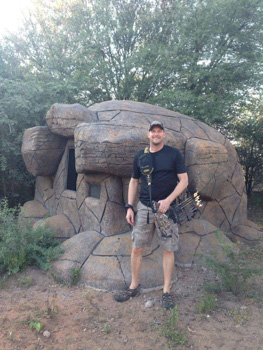
From bowhunting.net, bowhunting biologist Wade Nolan discusses some of the myths about traveling to Africa for a bowhunting safari. Below is a small sample of his article. If you want to read the entire document, it can be found here.
Few hunts raise more questions than a bowhunting safari in Africa. My intention is to shed light on an African Bowhunt and make you feel comfortable by unveiling the mysteries. Last time we Q & A talked about the land and the people plus a few universal fears that I debunked. This time we will discuss costs, flights accommodations and details on hunting.
Q- What are the flights like?
A- Overseas flights are conducted in the really big jets like 747 and 757’s. There will be 200 or more people on the flight. It is a long one with the longest leg lasting about 12 hours but the entire trip is more like 21-23 hours of flying. The jet will stop to refuel in Dakar West Africa or in France/Germany or even in Denmark (You do not want to route through Amsterdam however with hunting equipment) on some routes. The preferred route is out of Atlanta or DC Dulles with South African Air which stops once in Dakar to refuel. You will be overfed on these flights and I’ve never had a rough flight. You can bring 2 bags, 50# each plus a carry-on. I usually pack some camo clothes in my bow case. You don’t need a lot of clothes as anything you wear that you want washed will be washed, folded and placed on your bed daily. Always carry all of your optics/laptops and expensive stuff with you in the carry-on to be safe. You will be met at the airport and shuttled to the hunting lodge.
Q – What about a travel visa or passport?
A – You do not need a visa to visit any of the South African countries if you are staying less than 3 months. What you’ll need is a valid passport with at least 3 empty (unstamped pages). You can get one at any major post office. They are good for 10 years. They take about two months to get one from beginning to end so plan ahead.
Q- What does a bowhunting safari cost?
A – Bowhunting safaris in Africa are surprisingly reasonable and you’ll typically be way more successful than a hunt in North America … for virtually anything. It is common to pay $5000+ for a caribou hunt, and then there are license fees, plane tickets and lodging before and after the trip. Then if you add an additional caribou there may be another $1000 fee. It is easy to part with 6-7K for a caribou hunt and I have been on caribou hunts when we missed the migration and shot ptarmigan … no caribou.
Now let’s look at Africa. The success rate is usually above 80%+ per animal. There is no license or tags to buy. Unlike North America these hunts are driven by packages and by a menu approach. For instance, If you want to hunt a kudu, gemsbok and a wildebeest plus an impala there is a 4 animal package you can select that includes guiding/food lodging and these animals. The package would be cheaper than paying a trophy fee for each animal individually. In my experience over 90% of the guys buying a package will fill all of their tags. You don’t pay for animals you don’t get.
Q – What is the actual hunt like?
A – The day begins with a breakfast in the pre-sunrise dawn. The temp is in the 50’s but will be rising into the 70’s. The ride to the blind takes 20 minutes and you and your PH get comfortable and watch out of one-way mirror glass windows at the waterhole whose nearest edge sits at 16 yards and far bank is at 20. First Francolin hens squawk at the rising sun then a flock of native guinea hens file in with their salt and pepper football shaped bodies and get a drink.
In the distance you see a herd of springbok wandering in the Camel thorn trees. Eventually they approach the waterhole. All animals approach water holes with caution in Africa because this is where they often meet with leopards and crocs. Within minutes the herd of springbok, led by a mature buck are drinking.
As the day warms Hartman’s Zebra approach the waterhole and a fight breaks out between two stallions. Their aggressive calls sound like mad donkeys. Finally, they drink and leave. Then a small group of gemsbok approaches from behind and walks within 8 feet of the blind. At first you see only their legs passing by from your ground level view. The blind has sealed in your scent and they then dip their heads for a drink at 16 yards. You rise and bring your bow to full draw as your PH slides open the silent window and your finger feels for the release. The bull is quartering away … your finger tenses on the trigger.
Q – What are the hunting blinds like?
A – The blinds are custom built stone, brick or block construction and sunk into the ground so the shooting windows are at ground level. They are 8 x 8 and have a 7-foot ceiling. The floor is usually carpeted and the windows are vertical with views out 3 sides. They are air tight and capture your scent. Ventilation is via a roof vent. The glass is a one-way mirror with silent slide or silent swing opening options. They are typically cool due to their underground contact and usually placed under a shade tree and shadowed.
When you are seated you have a view to the waterhole without standing. There is plenty of room to draw your bow.